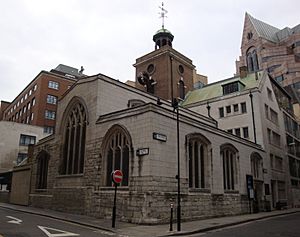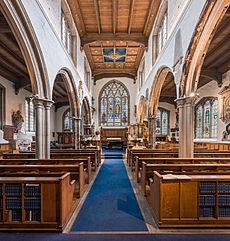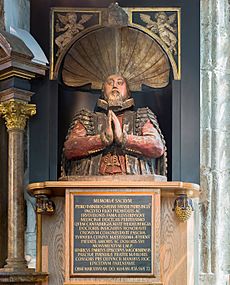St Olave's Church, Hart Street facts for kids
Quick facts for kids St Olave, Hart Street |
|
|---|---|
 |
|
| Location | London, EC3 |
| Country | England |
| Denomination | Church of England |
| Website | www.saintolave.com |
| Architecture | |
| Heritage designation | Grade I listed building |
| Style | Perpendicular Gothic |
| Years built | 1450 |
| Specifications | |
| Bells | 8 – Hung for full circle ringing |
| Administration | |
| Parish | St Olave Hart Street |
| Deanery | City of London Deanery |
| Archdeaconry | Archdeaconry of London |
| Diocese | London |
St Olave's Church, Hart Street, is a historic Church of England church in the City of London. It is located on the corner of Hart Street and Seething Lane, near Fenchurch Street railway station.
The famous poet John Betjeman once called St Olave's "a country church in the world of Seething Lane." It is one of the smallest churches in the city. Amazingly, it is also one of the very few medieval churches that survived the Great Fire of London in 1666. Today, it serves as the local parish church and is the official church for the Tower Ward of London.
Contents
The Story of St Olave's Church
Who was Saint Olave?
The first church on this site was likely made of wood. A stone church was built in the 13th century and was named St Olave-towards-the-Tower. It is dedicated to King Olaf II of Norway, who is the patron saint of Norway.
In 1014, Olaf fought with the Anglo-Saxon King Æthelred the Unready against Danish invaders in the Battle of London Bridge. It is believed the church was built on the site of this battle. Olaf was made a saint after his death. During World War II, King Haakon VII of Norway worshipped here while he was living in exile in London, strengthening the church's connection to Norway.
The church was rebuilt in the 13th century and again in the 15th century. The building we see today was built around 1450.
Surviving the Great Fire of London
St Olave's famously survived the Great Fire of London in 1666. This was thanks to Sir William Penn, an important navy officer. His men from the nearby naval yards blew up the houses around the church. This created a gap, called a firebreak, that stopped the fire from spreading.
The flames got as close as 100 yards away, but then the wind changed direction. This saved St Olave's and several other churches in the area.
Samuel Pepys's Favorite Church
The famous diarist Samuel Pepys loved this church. His home and his office for the Royal Navy were on Seething Lane, so he was a regular visitor. He called St. Olave's "our own church" in his diary.
In 1660, he had a special gallery built on the south wall of the church. He even added an outdoor staircase from his office so he could get to church without getting wet in the rain. When his wife Elisabeth died in 1669, Pepys had a marble statue of her head and shoulders made. He placed it on the north wall where he could see it from his seat. In 1703, Pepys was buried next to his wife in the church.
The "Saint Ghastly Grim" Gateway
The church has a spooky gateway leading to its churchyard, built in 1658. It is decorated with carvings of skulls and crossbones. The writer Charles Dickens was fascinated by it. In his book The Uncommercial Traveller, he nicknamed the church "Saint Ghastly Grim" because of the skulls.
The Latin words carved on the gate are from the Bible and mean: "For to me to live is Christ and to die is gain."
Bombed in the Blitz and Rebuilt
Sadly, the church was badly damaged by German bombs during the London Blitz in 1941. It was carefully restored and reopened in 1954. King Haakon VII of Norway returned for the special rededication ceremony. He placed a stone from Trondheim Cathedral in Norway in front of the altar to mark the occasion.
The church is now a Grade I listed building, which means it is officially recognized as a very important historic site.
Church Architecture and Design
From the outside, St Olave's looks like a simple church built in the Perpendicular Gothic style. It has a square tower made of stone and brick. The most famous feature is the spooky 1658 gateway with its carved skulls.
Inside, much of the church was rebuilt after the bombing in World War II. The space is almost a perfect square. It has three sections separated by stone columns and pointed arches. The wooden roof is simple but beautiful. While many of the decorations are modern, some important historical items survived. These include the monument to Samuel Pepys's wife and a wooden pulpit believed to be carved by the famous artist Grinling Gibbons.
Famous Burials and Memorials
The Boston Tea Party Connection
A memorial in the church tower once honored Monkhouse Davison and Abraham Newman. They were grocers who shipped tea to Boston in 1773. This tea was thrown into the harbor during the Boston Tea Party, an event that helped start the American War of Independence.
Mother Goose and the Great Plague
Some interesting people are said to be buried here. The church's records show that a woman known as the "Pantomime character" Mother Goose was buried here on September 14, 1586.
The churchyard is also said to hold the grave of Mary Ramsay. Many people believe she was the person who brought the Great Plague to London in 1665. The church records show she was buried on July 24, 1665. After that date, the names of plague victims in the records were marked with a 'p'.
The Church Bells
A stained-glass window in the church shows Queen Elizabeth I. In 1554, before she was queen, she was released from the Tower of London. She held a special service at St Olave's to give thanks. She gave silk bell-ropes to a nearby church, All Hallows Staining, because its bells rang the loudest to celebrate her freedom. When that church closed in 1870, the silk ropes were brought to St Olave's.
During the Blitz in 1941, a bomb hit the church tower. The fire was so hot that the eight church bells melted. In the 1950s, the metal was collected and used to make new bells. The same company that made the original bells, the Whitechapel Bell Foundry, cast the new ones.
Today, the church has a ring of eight bells. They are rung by the University of London Society of Change Ringers for practice on Thursdays and for the Sunday service.
The Missing Statue's Return
Peter Turner was a famous doctor in the 16th century. He and his father, William Turner, were both buried in the church. A memorial statue of Peter was placed in the church in 1614.
When the church was bombed in the Blitz, the statue disappeared. For over 70 years, no one knew where it was. Then, in 2010, it suddenly appeared at an art auction. Experts recognized it, and the sale was stopped. The statue was finally returned to its original spot in St Olave's in 2011.
Notable People Connected to the Church
- Queen Elizabeth I: Held a thanksgiving service here in 1554 after being released from the Tower of London.
- Sir Francis Walsingham: Queen Elizabeth I's spymaster, lived across the street.
- Samuel Pepys: The famous diarist, who was buried here in 1703 next to his wife.
- King Haakon VII of Norway: Worshipped here during his exile in London from 1940 to 1945.
Gallery
See also
- List of buildings that survived the Great Fire of London
- List of churches and cathedrals of London






